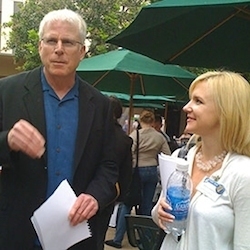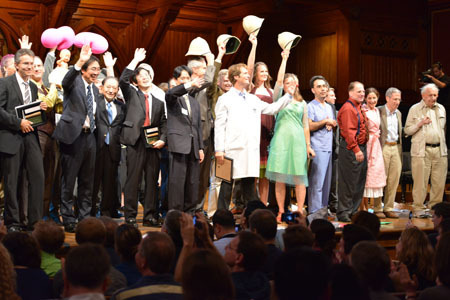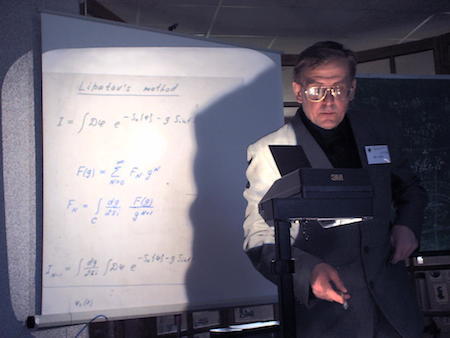Marc Abrahams's Blog, page 444
November 29, 2013
Numbers Stations – an anachronism ahead of their time?
 It’s 1963, the height of the Cold War. Safely out of sight and earshot, an international espionage agent sits furtively huddled over a short-wave radio, listening intently for strings of seemingly random numbers. Despite the high levels of static interference, they’re painstakingly written down, one by one, and later tabulated against a ‘one time pad‘ to reveal, letter by letter, the spy’s new instructions.
It’s 1963, the height of the Cold War. Safely out of sight and earshot, an international espionage agent sits furtively huddled over a short-wave radio, listening intently for strings of seemingly random numbers. Despite the high levels of static interference, they’re painstakingly written down, one by one, and later tabulated against a ‘one time pad‘ to reveal, letter by letter, the spy’s new instructions.
Scroll forward fifty years to 2013, when gigabytes of über-encrypted data might be transferred to an agent in a mouseclick – making the so-called ‘number-stations‘ seem anachronistic to the point of comedy. Odd then, that a number of the world’s superpowers (and some not-so-super) are still routinely using them.
And whoever chose the traditional English folksong ‘The Lincolnshire Poacher‘ as the call-sign for the now-famous number station known formally as ‘E3′, [click the pic to listen, .mp3 format] definitely had a well-tuned sense of humour. Poaching being an illegal, clandestine activity. As is high-power broadcasting on a protected waveband without a valid licence. As is, many might say, espionage itself.
Extensive details about how the numbers stations work were published for the first time in the journal Cryptologia Volume 31, Issue 4, 2007.
Amateur (de)cryptologists who fancy trying their hand at illegally* intercepting what is itself an illegal activity, might well use the impressive broadband online radio tuner provided free by the University of Twente in The Netherlands. The stations typically only appear for half an hour or so, and sometimes only on a designated day-of-the-week. Details of dozens of stations can be found here [search for “numbers”] And those who wish to listen-out for the infamous ‘Lincolnshire Poacher’ (should it reappear) will find the last-known transmission schedule and frequencies here.
* Note that simply ‘intercepting’ government messages which carry ‘secret’ information (even though in this case they are broadcast to the entire world, and despite the fact that you can’t decrypt them) is deemed illegal in several countries.
BONUSES
● Many more number station recordings can be heard here:
● A video showing an a-capella choir quartet of ‘Speech/Morse Generators’ (as formerly used by the STASI &etc) performing in unison.

Controversy upon controversy: Not “Float, explode, or sink”, but rather *implode*?
The 2012 study ”Float, explode or sink: postmortem fate of lung-breathing marine vertebrates,” which [as we mentioned here yesterday] was awarded the prestigious Senckenberg Award, does have its detractors. Or rather, detractor. Who advances a theory that certain carcasses implode.
A.J. Van Loon [pictured here] of Adam Miczkiewicz University, Poznan, Poland, published a commentary about explaining why he believes this to be the case:
“Ichthyosaur embryos outside the mother body: not due to carcass explosion but to carcass implosion,” A.J. van Loon,Palaeobiodiversity and Palaeoenvironments, March 2013, Volume 93, Issue 1, pp 103-109. He writes:
“Some well-preserved ichthyosaurs found in the Early Jurassic Posidonienschiefer Formation at Holzmaden (Germany) have puzzled palaeontologists for a long time: their skeletons are exceptionally well preserved and their bones are almost all in situ, but the bones of their embryos are scattered, partly beyond the body limits of themother. This has been explained initially by bottom currents and later by a displacement of already disarticulated embryos during the expulsion of putrefaction gases through the disrupted body wall of the mother. It was postulated recently that this latter hypothesis is not tenable. It is argued here that both hypotheses are not tenable in their original form, but that carcass implosion may explain the various enigmatic features.”
Here’s a video of Achim Reisdorf, lead author of the “Float, explode or sink” study, giving his take on the matter, at the recent Frankfurter Science Slam:
BONUS: The Paleomansam blog’s take on this.

November 28, 2013
Ig Nobel day-after-Thanksgiving broadcast on Science Friday
Spread the word, please! Today, Friday, November 29, the Science Friday radio program will broadcast its specially edited recording of the 2013 Ig Nobel Prize ceremony. It’s SciFri’s 22nd annual broadcast (SciFri began this day-after-Thanksgiving tradition in 1992, the Ig Nobel ceremony’s second year).
Listen to it on an NPR station, if you’re near one, or on the Internet.
The photo below shows (just!) some of the 2013 Ig Nobel Prize winners, the Nobel laureates who handed out the prizes, the 24/7 Lecturers, and the cast and the medical-all-stars orchestra of the mini-opera ‘The Blonsky Device’. (If you look carefully, you can spot the baby that was born at the thrilling, centrifugal-force-filled conclusion to the opera!). Mike Benveniste took this photo:
BONUS: Science Friday asked journalist Carmen Nobel (yes, that is her name) to visit the Ig Nobel after-party. Her writeup, on the Science Friday site, is called ”Small Talk with Scientists: The Ig Nobel Prize Winners Unwind“.
BONUS: Download your own copy of IgBill, the printed program for the 2013 ceremony, and the 2013 ceremony poster.
BONUS: From SciFri archives, here’s last year (2012)’s Ig Nobel broadcast.
BONUS: The special Ig Nobel 2012 issue of the Annals of Improbable Research

Float/explode/sink carcass study wins Senckenberg Award
Joyous news about a contrarian study of upside-down-carcass theory, reported this month in the journal that published the study:
“Authors of outstanding article receive Senckenberg Award!” Palaeobiodiversity and Palaeoenvironments, November 2013.
We are pleased to announce, that the Alexander von Humboldt-Gedächtnispreis 2013 was awarded to authors of the following article, published in the special issue of Palaeobiodiversity and Palaeoenvironments entitled Taphonomic processes in terrestrial and marine environments (Wuttke M, Reisdorf AG (eds)): Achim G. Reisdorf [pictured here], Roman Bux, Daniel Wyler, Mark Benecke, Christian Klug, Michael W. Maisch, Peter Fornaro, Andreas Wetzel, “Float, explode or sink: postmortem fate of lung-breathing marine vertebrates,” [March 2012], Volume 92, Issue 1, pp 67-81.
Here’s video of the lead author: “Achim Reisdorf ‘Dinoleichen – wie habt ihr euch verändert?‘”
BONUS: Our profile of the study, a while back, in The Guardian.
BONUS: A musical work composed in honor of the topic

Measures must be taken, maybe. But what do they mean?
Hadas Shema muses on the importance, or lack of importance, of certain new measurements — measurements of the supposed “impact” of a published study. She writes, in Scientific American‘s Information Culture blog:
When in trouble or in doubt, invent new words. We have bibliometrics and scientometrics from the Age of Print. Now they are joined by informetrics, cybermetrics, webometrics and altmetrics… Psychology speaking, there’s something exciting about alternative metrics. You can watch the metrics go up daily, an almost instant gratification, while citation-based gratification can take years. On the other hand, that’s a lot of pressure. Is my article being covered in blogs, tweeted, bookmarked? And what does it even mean? …
Not all alternative metrics sources were born equal. I’m very biased here, but I don’t think one can study a lot from the number of tweets. An article can be tweeted because it has a catchy title or won an Ig-Nobel prize, but that’s not going to tell us much about its scholarly impact. Now that I think of it, winning an Ig-Nobel can also earn you blog coverage, so it’s maybe not a good example, but in general, I think that genuine (not promotional/spam) blog coverage says more about an article’s future impact than tweets. Twitter is about dissemination of news, it does not require deep thought and consideration.
Shema’s thoughts here are in harmony with those of our old, departed friend Jerry Lettvin, who loved to say, about many things in academia: “If you can measure it, it must be important!”

He multiplied two 10-digit numbers in his head, in just 7 hours
Computer access to a stack of photos can be used to boost one’s mental calculating ability, suggests this paper. Do pay attention to the thought in parentheses, at the very end of this quotation:
“Multiplying 10-digit numbers using Flickr: The power of recognition memory,” Andrew Drucker [pictured here], 2011. The author, at MIT, explains:
In this informal article, I’ll describe the “recognition method”|a simple, powerful technique for memorization and mental calculation. Compared to traditional memorization techniques, which use elaborate encoding and visualization processes, the recognition method is easy to learn and requires relatively little effort.
There is a catch: to apply the method, you need continuous access to a large collection of interesting, unfamiliar photographs. (This is easy to set up on a home computer, using the photo-sharing website Flickr.com, and I’ll explain how.) The basic idea for the method is not new; it comes from the psychological literature, and has been applied by computer scientists to the design of computer password systems….
Putting it to the test: On a sunny California day in June 2011, I grabbed some numbers from a table of random digits. In 7 hours of work, I used the recognition method to calculate
9883603368 X 4288997768 = 42390752785149282624
I have no special abilities or memory training, and what I did was not really a feat. I firmly believe that an average person who knows how to multiply could do the same thing with a little training (and do it much faster, with practice).

A man — Mikhailovich — obsessed, computationally, with laughter
Suslov Igor Mikhailovich, Doctor of Science, who is Head Scientist at the P.L. Kapitza Institute for Physical Problems, has been working steadily towards a goal: creating a computer with a sense of humor. The photo below shows Mikhailovich projecting his thoughts. Here are four of his research papers on the matter:
1. arXiv:0711.3197 [pdf, ps, other]
How to realize “a sense of humour” in computers ?
I. M. Suslov (P.L.Kapitza Institute for Physical Problems, Moscow, Russia)
Comments: 14 pages, 6 figures included, 2007
Subjects: Computation and Language (cs.CL); Artificial Intelligence (cs.AI); Neurons and Cognition (q-bio.NC)2. arXiv:0711.2270 [pdf, ps, other]
Can a Computer Laugh ?
I. M. Suslov (P.L.Kapitza Institute for Physical Problems, Moscow, Russia)
Comments: English translation of the paper in Russian; 18 pages, 6 figures included
Journal-ref: Computer Chronicle (Moscow), 1994, issue 1, p.1
Subjects: Computation and Language (cs.CL); Artificial Intelligence (cs.AI); Neurons and Cognition (q-bio.NC)3. arXiv:0711.2061 [pdf, ps, other]
Computer Model of a “Sense of Humour”. II. Realization in Neural Networks
I. M. Suslov (P.L.Kapitza Institute for Physical Problems, Moscow, Russia)
Comments: 13 pages, 5 figures included; continuation of this series to appear
Journal-ref: Biofizika SSSR 37, 325 (1992) [Biophysics 37, 249 (1992)]
Subjects: Neurons and Cognition (q-bio.NC); Artificial Intelligence (cs.AI)4. arXiv:0711.2058 [pdf, ps, other]
Computer Model of a “Sense of Humour”. I. General Algorithm
I. M. Suslov (P.L.Kapitza Institute for Physical Problems, Moscow, Russia)
Comments: 10 pages, 3 figures included; continuation of this series to appear
Journal-ref: Biofizika SSSR 37, 318 (1992) [Biophysics 37, 242 (1992)]
 BONUS: An earlier Mickhailovich worked in the opposite direction, The following passage is from the study ”The Social Meanings of Swearing: Workers and Bad Language in Late Imperial and Early Soviet Russia,” S.A. Smith, Past & Present, No. 160 (Aug., 1998), pp. 167-202.:
BONUS: An earlier Mickhailovich worked in the opposite direction, The following passage is from the study ”The Social Meanings of Swearing: Workers and Bad Language in Late Imperial and Early Soviet Russia,” S.A. Smith, Past & Present, No. 160 (Aug., 1998), pp. 167-202.:
“carnivalesque use of language was associated in Russia with the skomorokhi, minstrels whose singing, dancing and bear-baiting were standard fare at festivities. In 1648, a time of intense popular unrest, tsar Aleksei Mikhailovich banned these minstrels, making specific reference to their singing ‘impious and foul songs’”.
BONUS (unrelated): “On the Existence of Mikhailov”

November 27, 2013
Goats in and as sweaters
Goats in sweaters (via @EmilyAnthes):
Photo Essay: Goats in Sweaters
By Reyhan Harmanci, Modern Farmer, November 26, 2013
For the past 17 years, Brooklyn-based artist Alexander Gorlizki has been traveling to Jaipur, India, to work. And while there over the last few years, he began photographing something very exciting: goats wearing sweaters….
Goats as sweaters;
“An explanation of this discrepancy could be that the Nubian goats were better sweaters than the Swiss goats, since a profusely sweating skin remains relatively cool and therefore stimulates respiratory rate less than a poorly sweating and therefore warm skin.”
—from ”Physiological reactions of three breeds of goats to cold, heat and high altitude,” W. Bianca and P. Kunz, Livestock Production Science, vol. 5, no. 1 (1978): 57-69. The authors are or were at the Swiss Federal Institute of Technology.
BONUS: A goat truth
BONUS: The men who startled goats
BONUS (unrelated, unless goat hair is involved): “Sony files patent for ‘SmartWig’” [reported by Circa):

A tribute to regret and regrets
 Amanda Hess pays tribute, in Slate, to certain researchers [pictured here] and their research. Her tribute begins thus:
Amanda Hess pays tribute, in Slate, to certain researchers [pictured here] and their research. Her tribute begins thus:
College Men and Women Express Different Sexual Regrets. Could Cave People Be to Blame?
In a new study published in the Archives of Sexual Behavior, a team of evolutionary psychologists queried 200 American college students on their greatest romantic and sexual regrets. They found that the female students were more likely to express regret over sexual actions they’d taken—like “losing their virginity” to the “wrong partner”—while male students were more likely to feel remorse over actions they did not take—like being “too shy to indicate sexual attraction to someone.” …
BONUS: Videos of a woman and a man, each singing about a lack of regret:

Tongue ID
[sometimes it seems as though] As soon a new biometric security technology is developed, someone will find a way to bypass it. (see, for example, Progress in Fake-Finger Thwarting Improbable Research, April 16th, 2010).
Steps towards implementing so-called ‘liveness detection’ mechanisms, which detect inert fakes, have helped. But in an ideal world, biometricians would like to be able to develop a system in which it’s not only very hard to forge fakes, but that also has a very obvious inherent ‘liveness’ component.
Just such a system is proposed by professor David Zhang. BSc Peking, MS PhD HIT, PhD Waterloo, FIEEE, FIAPR and colleagues at the Biometric Research Centre, of The Hong Kong Polytechnic University. Their new system is based around tongue recognition.
“The tongue is a unique organ in that it can be stuck out of mouth for inspection, and yet it is otherwise well protected in the mouth and is difficult to forge. The tongue also presents both geometric shape information and physiological texture information which are potentially useful in identity verification applications. Furthermore, the act of physically reaching or thrusting out is a convincing proof for the liveness. Despite these obvious advantages for biometrics, little work has hitherto been done on this topic.”
The team presented details of their work in : ‘Tongue-Print: A Novel Biometrics Pattern’ Lecture Notes in Computer Science, Volume 4642, 2007, pp 1174-1183. [press the 'Look Inside' button on the right hand side of the page to 'Look Inside'] Two years later professor Zhang et al. applied for a US patent on the idea – and, despite the fact that considerable detail had been publicly revealed in their paper two years earlier, they were granted their patent: ‘Method and system for identifying a person based on their tongue’ in 2013. The patent provides further details on the built-in liveness aspect, which the authors call ‘squirm’.
“An involuntary squirm of the tongue to detect whether the person is alive may be determined by capturing the images from a front view of the tongue protruding from the mouth and naturally spread.“
Note: If the technology ever becomes mainstream, say, for example, to log-on to your mobile, or start your car, or withdraw cash at an ATM, there could be public etiquette issues – which neither the paper nor the patent discuss.
BONUS: Uvula, Uvula, Uvula

Marc Abrahams's Blog
- Marc Abrahams's profile
- 14 followers








